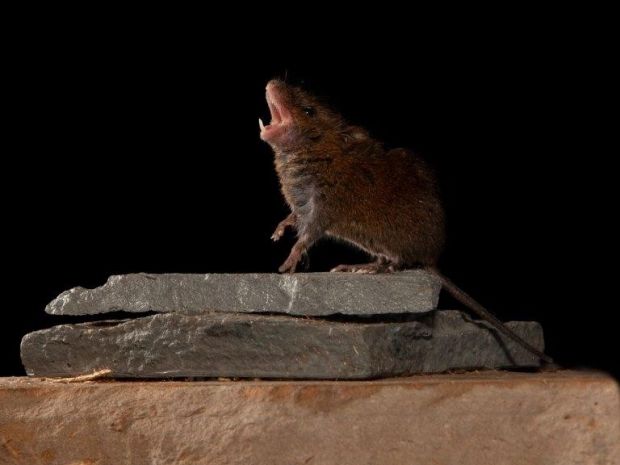Meet the Singing Mice of Central America
The vocal critters could help scientists better understand the mechanics of human conversation
:focal(307x228:308x229)/https://tf-cmsv2-smithsonianmag-media.s3.amazonaws.com/filer/56/86/56863a8f-5462-41ec-9fc0-7b3d910e70a4/screen_shot_2019-03-01_at_115441_am.png)
A singular mouse species found in the cloud forests of Central America boasts a musical repertoire of nearly 100 notes. But Scotinomys teguina, better known as Alston’s singing mouse, isn’t impressive solely for its vocal range. As Popular Science’s Jessica Boddy explains, the lyrical critter is capable of engaging in high-speed duets that mirror the pace and back-and-forth nature of human conversation.
Now, Jennifer Ouellette reports for Ars Technica, researchers from New York University’s School of Medicine and the University of Texas at Austin have identified the neural circuit responsible for these singing mice’s turn-taking performances. The team’s findings, published in the journal Science, mark the first time scientists have pinpointed such coordination to a specific region of the mammalian brain. Previously, The New York Times’ Carl Zimmer writes, the dominant theory argued that non-human mammals relied on simple brain circuits for communication and lacked the mechanisms needed to produce controlled, complex speech.
If a “vocal coordination center” similar to the singing mouse’s newly dubbed orofacial motor cortex (OMC) can be located in the human brain, study co-author Michael Long of NYU tells Ouellette, it may hold the key to developing more effective treatments for individuals with communication disorders.
“We need to understand how our brains generate verbal replies instantly using nearly a hundred muscles if we are to design new treatments for the many Americans for whom this process has failed, often because of diseases such as autism or traumatic events, like [a] stroke,” Long adds in a statement.

To better understand the rodents’ chirpy songs, Long and his colleagues transported a group of Alston’s singing mice from Costa Rica to New York City.
“They’re kind of divas,” Long admits to the Times’ Zimmer. Indeed, Laura Sanders points out for Science News, the critters require larger terrariums than their average lab mouse counterparts, as well as specialized exercise equipment and a fancy diet of fresh meal worm, dry cat food and fruit. Still, Long says, “They thrive[d] here.”
According to Zimmer, the mice’s arias can last up to 16 seconds. Although the music-makers are known to offer up tunes while alone, their most thunderous performances occur in the company of others. Male mice turn to song while battling over territory, while males and females serenade each other during courtship. Each creature’s pattern of chirps is unique, as Long tells Science magazine’s Kelly Servick. “I can recognize this one particular song and say, ‘Ah, that’s Ralph,’” he explains.
Popular Science’s Boddy writes that the researchers launched their investigation with a pair of mice housed in a cage where they could hear but not see each other. Surprisingly, study co-author Arkarup Banerjee of NYU tells Boddy, the animals appeared to be more polite than most humans. By remaining aware of when a fellow mouse was ready to start or stop its song, the mice avoided interrupting each other, instead breaking out into song within a split second of a peer’s closing note.
Once the scientists had mapped out this communication etiquette, they moved on to identifying the exact brain region responsible for the sounds. This circuit, known as the OMC, wielded a significant amount of control over the mice’s music-making abilities. When the team overstimulated the OMC with electrodes, the critters grew confused and sang the wrong notes. But when the team cooled down that same region, the mice retained their musical catalogue, even adding an extra few notes to extend the song.
Crucially, Servick explains for Science magazine, the researchers don’t think the OMC is responsible for producing the mice’s vocalizations. A set of trials where the team used nerve-blocking drugs to deactivate mice’s OMCs found the rodents struggling to respond to their peers’ songs but still able to carry tunes on their own. It’s likely, therefore, that the OMC functions as a “higher-level conductor” working in tandem with a still-to-be-identified song-generating region.
Moving forward, Long and his colleagues plan on exploring how their rodent-focused research relates to the human brain. As Long tells Ars Technica’s Ouellette, the mouse study points toward the need to examine the brain “in the context of interaction.”
The team hasn’t found the key to treating humans' communication disorders just yet. “[But] do we have a new tool in the fight?” Long asks.
“We sure do,” he says to Ouellette, “[and] that’s what fills me with hope.”
/https://tf-cmsv2-smithsonianmag-media.s3.amazonaws.com/accounts/headshot/mellon.png)


/https://tf-cmsv2-smithsonianmag-media.s3.amazonaws.com/accounts/headshot/mellon.png)